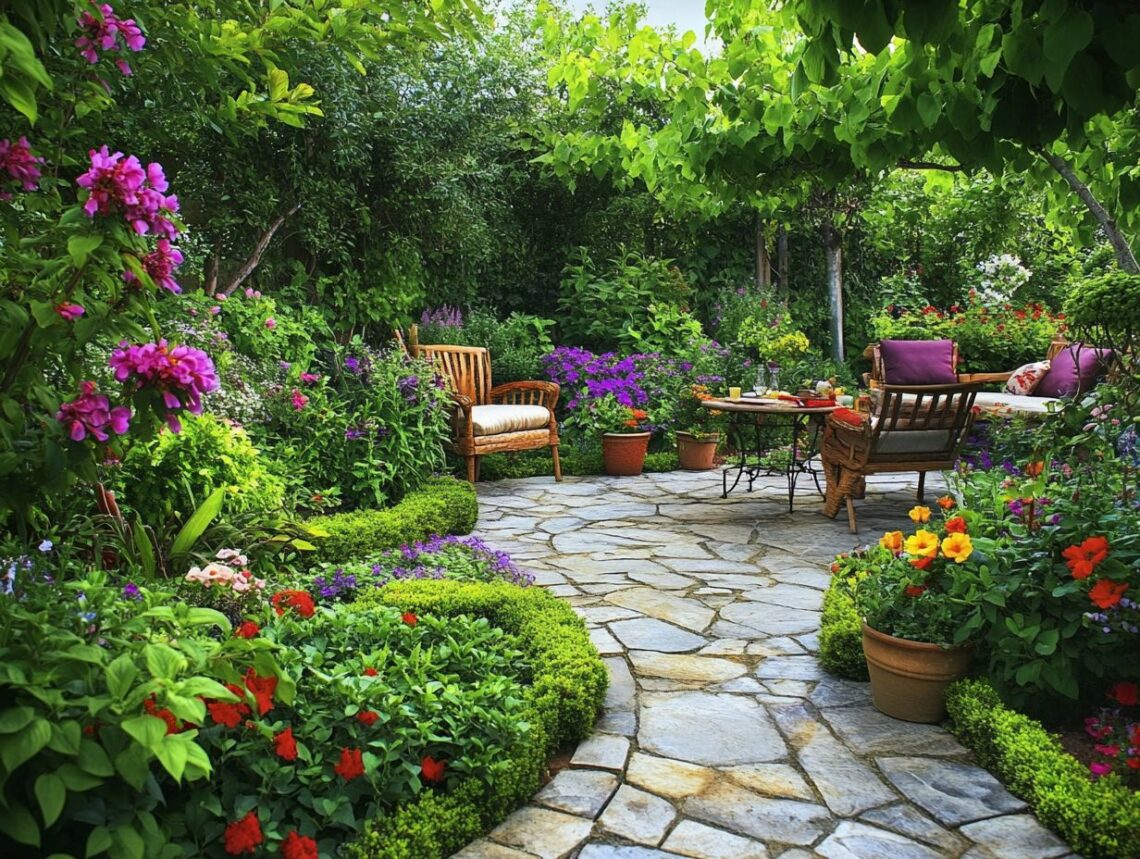
Best Landscaping Ideas for a Beautiful Home Garden
Transforming your home garden into a stunning oasis is easier than you think! This guide presents a carefully curated selection of the best landscaping ideas that enhance both beauty and functionality.
From wavy beds and blooming flower borders to fragrant plants and outdoor seating areas, each concept is designed to inspire creativity. Whether you’re drawn to native plantings or intrigued by vertical gardens, there’s something here for every gardening enthusiast.
Discover how to elevate your garden’s appeal!
Wavy Beds

Wavy beds can significantly enhance the aesthetic of any garden landscape, providing a visually striking alternative to traditional straight lines.
These undulating shapes not only disrupt the monotony of rigid borders but also create an inviting flow that guides the observer’s eye throughout the garden space. By integrating native plantings into these wavy designs, landscape professionals can promote biodiversity while ensuring that the plants flourish within their natural environment.
This strategy not only cultivates a more sustainable garden but also facilitates the creative combination of textures and colors that elegantly traverse the curves of the beds. The outcome is a vibrant ecosystem where each twist and turn unveils a new dimension of flora, transforming the garden into a captivating retreat for both visitors and wildlife alike.
Structured Greenery
Structured greenery is a critical component of landscape design, serving as a foundational element that complements other aspects of a well-designed home garden.
By incorporating precisely defined hedges, topiaries, and ornamental grasses, homeowners can create a sense of balance and order that significantly enhances the aesthetic appeal of their outdoor spaces. This design methodology not only directs the viewer’s attention but also establishes functional areas conducive to relaxation and enjoyment.
Landscape designers play a crucial role in bringing these visions to life by selecting appropriate plant species, such as boxwood, yew, or lavender, that thrive within structured environments. These plants not only provide visual interest but also contribute to the overall harmony of the garden, transforming it into a sanctuary that exudes peace and tranquility.
Blooming Flower Borders
Blooming flower borders serve as an excellent method to establish vibrant, colorful pathways within a garden, thereby enhancing its overall visual appeal.
These borders guide individuals through the landscape while imparting a sense of tranquility and beauty to the environment. When strategically positioned alongside garden paths, they have the potential to transform ordinary walkways into captivating experiences that encourage visitors to wander and explore.
The incorporation of flowering vines, which elegantly climb trellises or gracefully drape over arbors, adds an additional layer of charm, resulting in a lush, immersive atmosphere. This harmonious combination of flower borders and vines not only attracts pollinators but also invites individuals to pause and appreciate the artistry of nature, thereby enriching the overall garden experience.
Native Plantings
Native plantings are not only aesthetically pleasing but also crucial for promoting biodiversity and sustainability in garden restoration projects.
Utilizing these plants creates a more harmonious environment, as they are inherently suited to the local soil, climate, and wildlife. By incorporating native species into landscaping, individuals can establish visually appealing, low-maintenance gardens that attract essential pollinators, such as bees and butterflies, thereby contributing to a vibrant ecosystem.
These plants generally require less water and fewer fertilizers, which aligns seamlessly with sustainable gardening practices. When landscapers prioritize native plants, they enhance the aesthetic value of outdoor spaces while also playing a significant role in preserving local flora and fauna, ensuring their continued prosperity for future generations.
Beautiful Garden Paths

Beautifully designed garden paths have the potential to transform outdoor spaces into serene retreats, guiding visitors through the unique features and diverse plant life of the garden.
A variety of materials and designs can enhance these pathways, facilitating a harmonious blend of functionality and aesthetics. For example, flagstone or brick can impart a rustic charm, while gravel offers a more casual, natural appearance.
Integrating the pathways with surrounding outdoor structures, such as arbors, benches, or water features, fosters a cohesive connection within the garden. Additionally, the strategic arrangement of flowers and shrubs alongside the path can further elevate the inviting atmosphere, ensuring that each stroll through the garden becomes an enjoyable experience that captivates the senses.
Fragrant Plants
Incorporating fragrant plants into a garden can significantly enhance the outdoor living experience by providing sensory delights that promote relaxation and tranquility.
These plants not only serve as visual focal points but also act as aromatic enhancements that uplift the spirit. For instance, placing lavender near a seating area can create a calming retreat, as its soothing scent contributes to a serene atmosphere. Similarly, jasmine can be trained to climb along trellises, filling the air with its sweet fragrance, particularly during the evening hours.
Other options, such as rosemary and mint, offer both delightful aromas and culinary benefits, enriching outdoor gatherings. Collectively, these fragrant varieties transform a typical garden into a peaceful escape, inviting moments of contemplation and fostering a deeper connection with nature.
Quaint Fencing
Quaint fencing can significantly enhance the charm and character of a garden, improving its overall curb appeal while effectively delineating different spaces.
By incorporating a variety of styles such as picket, lattice, or wrought iron, garden fencing fulfills a practical purpose while simultaneously serving as a visual statement that complements the natural beauty of outdoor designs. For example, a rustic wooden fence can elegantly frame a wildflower garden, whereas an ornate iron design may accentuate a more formal landscape.
This meticulous attention to detail can greatly influence the ambiance of the outdoor area, guiding visitors through the space and creating cohesive transitions between various sections of the garden. Ultimately, selecting the appropriate fencing style not only enhances functionality and privacy but also contributes to the overall aesthetic appeal.
Stone Features and Partitions
Incorporating stone features and partitions into a garden can create striking focal points that enhance both the aesthetic appeal and structural integrity of outdoor living spaces.
These elements not only define specific areas within the landscape but also contribute to a sense of harmony and balance. Various types of stone, including granite, slate, and limestone, can be utilized creatively to align with different themes and styles, whether rustic or modern.
Pathways lined with smooth pebbles can effectively guide visitors through the garden, while retaining walls serve both a functional purpose and add vertical interest and texture to the landscape. Water features, such as stone fountains or ponds, introduce a soothing auditory element, while seating areas constructed from natural stone encourage relaxation and contemplation.
By thoughtfully integrating these features into landscape design, it is possible to achieve a cohesive and inviting outdoor environment that celebrates the beauty of nature.
Outdoor Seating Areas

Outdoor seating areas constitute essential components of a garden paradise, offering spaces for relaxation and the enjoyment of the surrounding beauty.
These tranquil locations invite individuals to unwind and immerse themselves in the sights, sounds, and scents of nature. When contemplating the design, various styles and materials can be considered, each contributing uniquely to the overall ambiance.
From rustic wooden benches that harmoniously work together with natural surroundings to sleek aluminum chairs that provide a contemporary touch, the options are extensive. Cushioned lounge seats can transform a simple nook into an inviting retreat, while woven rattan infuses a cozy charm.
Incorporating elements such as fire pits or pergolas can further enhance the experience, creating a truly captivating outdoor environment.
Decorative Gravel and Mulch
Decorative gravel and mulch fulfill both functional and aesthetic roles in garden paths, enhancing the overall beauty of landscaping while promoting soil health.
Various types of decorative gravel, such as river rock, pea gravel, and crushed stone, offer distinct textures and colors that can complement a range of garden themes. In parallel, organic mulches, including bark chips and straw, serve to suppress weed growth, improve soil moisture retention, and provide essential nutrients as they decompose.
By incorporating these materials, one can establish inviting walkways that not only attract attention but also encourage exploration, all while maintaining soil integrity. The judicious selection of gravel and mulch can effectively prevent erosion and support the growth of surrounding plants, ensuring that the garden remains vibrant and healthy throughout the changing seasons.
Vibrant Window Boxes
Vibrant window boxes can add a significant aesthetic enhancement to any residence, showcasing an array of plants and enriching the overall landscape design.
These appealing features frame windows with an inviting charm, creating a visual statement that reflects the homeowner’s personality and style. Window boxes serve not only as a platform for flowering plants but also offer a unique opportunity to experiment with a variety of foliage and herbs, as many species thrive in such limited spaces.
Plants such as lavender, petunias, or cascading ivy are well-suited for window boxes and can flourish remarkably. When properly maintained, window boxes can greatly enhance curb appeal, capturing the attention of passersby and fostering a warm, welcoming environment that complements the architecture of the home.
Poolside Landscaping Ideas
Poolside landscaping ideas have the potential to transform a standard pool area into an oasis of relaxation and enjoyment, thereby enhancing outdoor living experiences.
By meticulously selecting a combination of lush greenery, inviting seating arrangements, and distinctive aesthetic features, one can establish an environment that promotes rest and rejuvenation. It may be beneficial to incorporate fragrant flowering plants that not only introduce vibrant colors but also create a soothing aroma for those lounging nearby.
Comfortable loungers, when positioned strategically around the pool, can encourage long afternoons spent basking in the sun, while shaded pergolas adorned with climbing vines provide necessary relief from the heat.
Furthermore, water features such as gentle fountains or small waterfalls can enhance the tranquil ambiance, offering the ideal backdrop for afternoon gatherings or quiet retreats.
Enchanting Alfresco Spaces

Enchanting alfresco spaces provide an ideal setting for appreciating the beauty of nature while engaging in outdoor living, transforming your garden into a true paradise.
These exquisite outdoor environments not only extend the living space of your home but also foster an inviting atmosphere where cherished memories can be created. By selecting comfortable furnishings, such as plush sofas or hammocks, hosts can easily encourage friends and family to relax and enjoy the fresh air.
Incorporating lush greenery—such as vibrant potted plants and cascading vines—further enriches the ambiance while enhancing the overall aesthetic appeal. Thoughtfully chosen décor elements, ranging from twinkling fairy lights to colorful cushions, can elevate these spaces into cozy retreats, ensuring that each outdoor gathering is both special and memorable.
Vertical Gardens and Green Walls
Vertical gardens and green walls represent innovative landscape design solutions that optimize space while offering abundant greenery and visual appeal.
These installations not only enhance the aesthetic quality of urban environments but also provide a sustainable approach to gardening, making them particularly suitable for areas with limited space. Homeowners and businesses are increasingly acknowledging the advantages of integrating these living walls, which can accommodate a diverse range of plants, including vibrant flowers, resilient succulents, and aromatic herbs.
Plus their visual benefits, vertical gardens significantly contribute to improving air quality by filtering pollutants and generating oxygen, thereby fostering healthier living environments. As more individuals recognize the versatility and practicality of these green structures, the popularity of living walls is poised to grow substantially.
Creative Lighting Solutions
Creative lighting solutions can significantly enhance outdoor living spaces by illuminating pathways and features while establishing a distinct ambiance within the garden.
These lighting options, which range from subtle path lighting to striking spotlighting, play a vital role in landscape design by directing the viewer’s attention and emphasizing architectural elements. Thoughtfully positioned fixtures have the potential to transform ordinary plants into captivating focal points at night, allowing their textures and colors to be appreciated in new and vibrant ways.
By employing a combination of ambient, task, and decorative lighting, one can curate a tranquil atmosphere that promotes relaxation and social interaction. Through the integration of these techniques, a garden not only becomes functional after dark but also acquires an enchanting quality that encourages exploration and enjoyment.
Seasonal Planting Tips
Seasonal planting tips are essential for ensuring a garden’s success throughout the year, allowing for the selection of optimal plants for each season.
By aligning the planting schedule with natural growth cycles, one can cultivate a vibrant landscape that not only thrives but also positively impacts the local ecosystem. For example, choosing early-blooming perennials in the spring can establish a pollinator-friendly environment, while incorporating drought-resistant plants during the summer promotes sustainability.
In the fall, introducing bulbs and cover crops enhances soil quality, setting the stage for a vigorous revival in the spring. A comprehensive understanding of the specific needs of various plants, alongside seasonal climatic conditions, will facilitate effective garden restoration, ultimately resulting in a flourishing and diverse garden that supports both aesthetic appeal and biodiversity.




